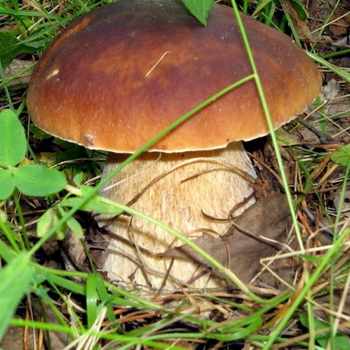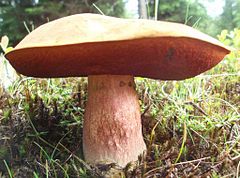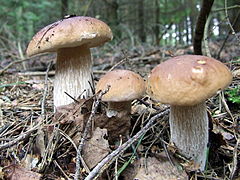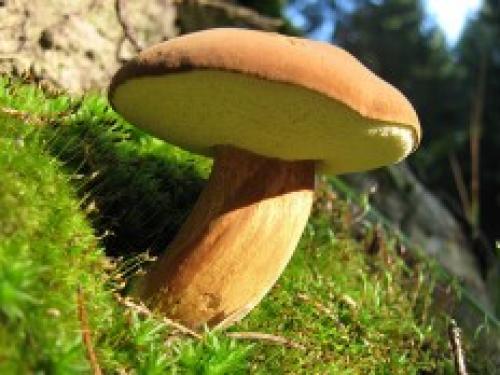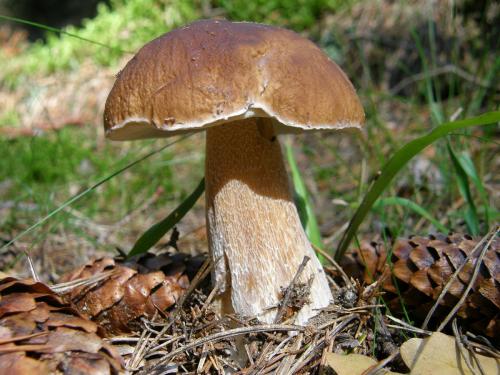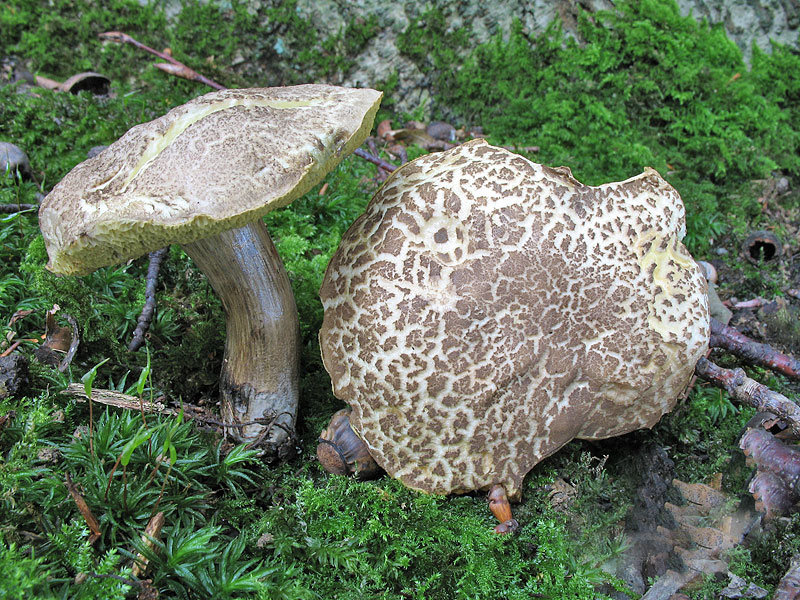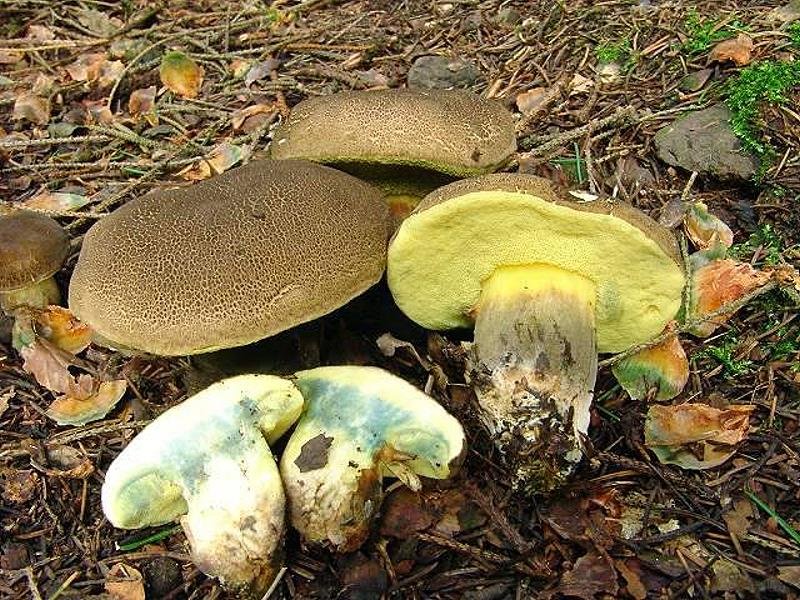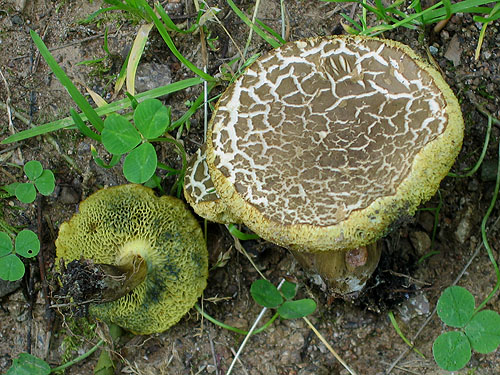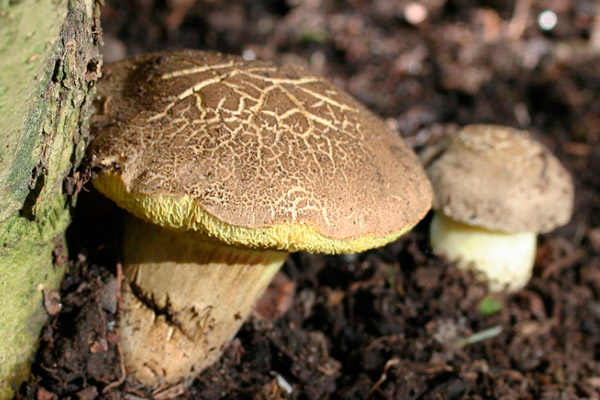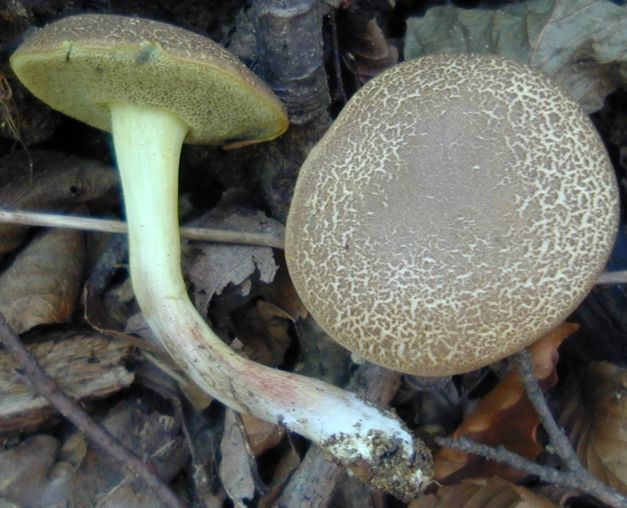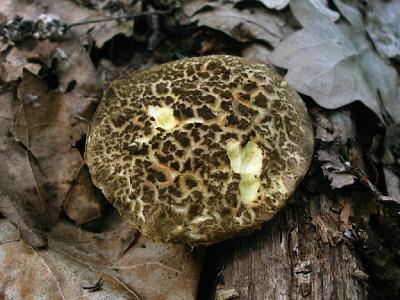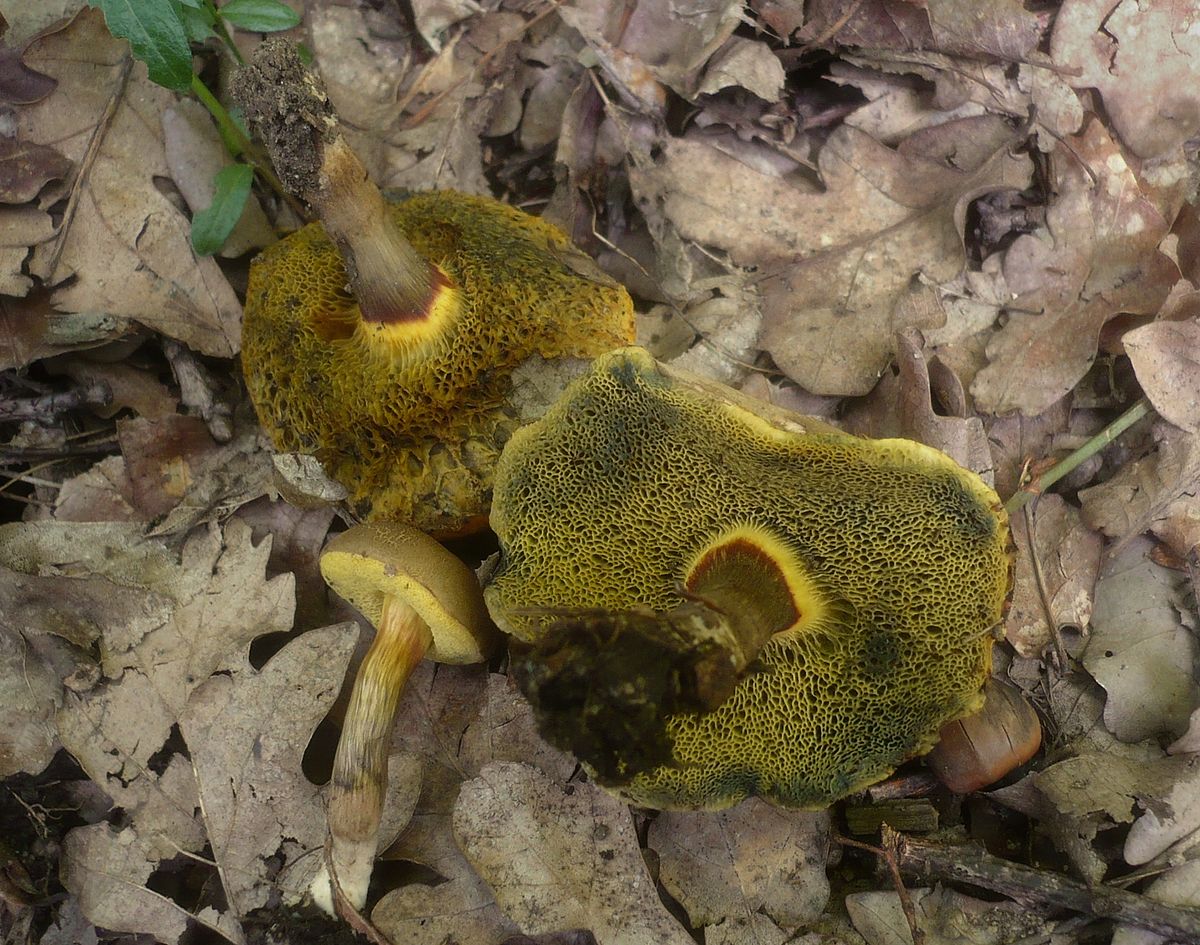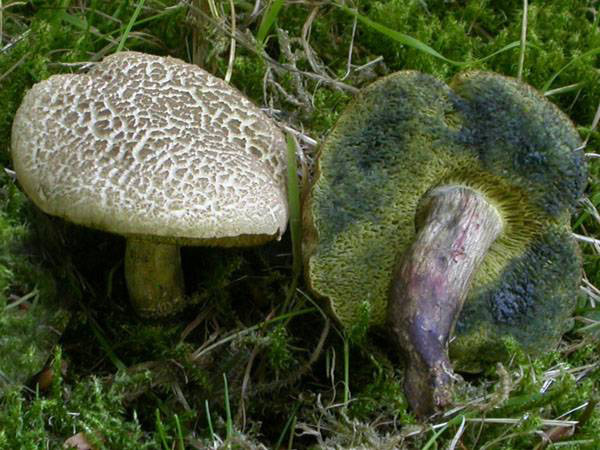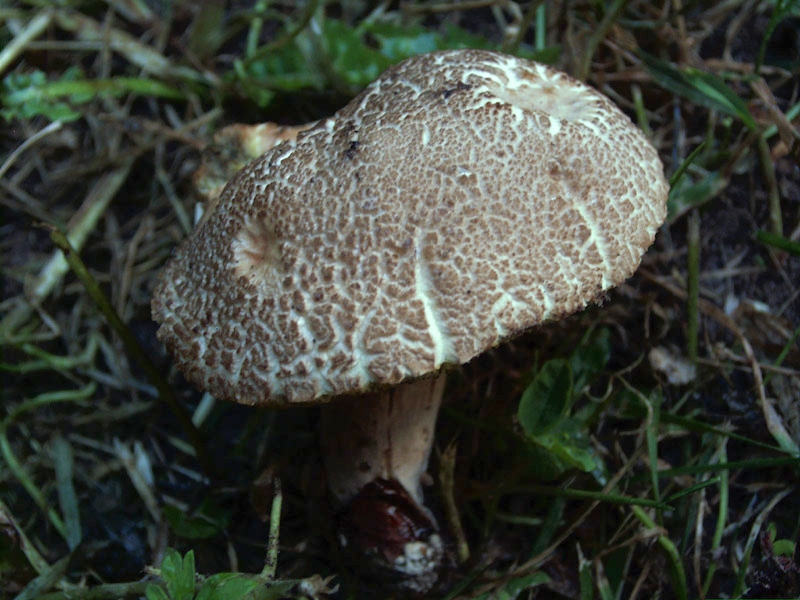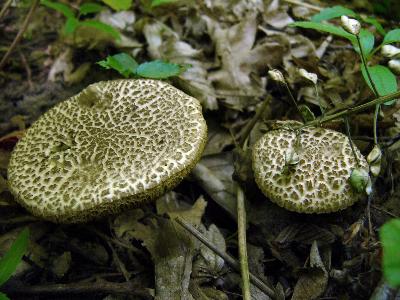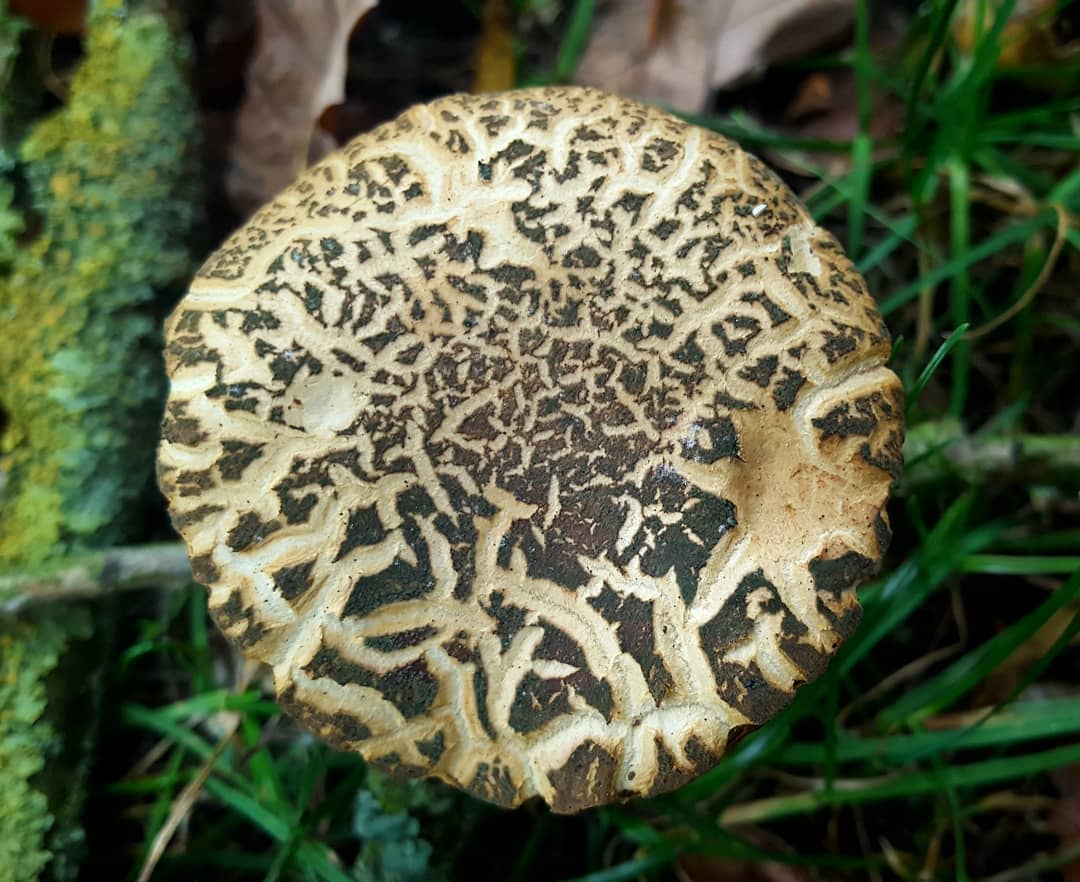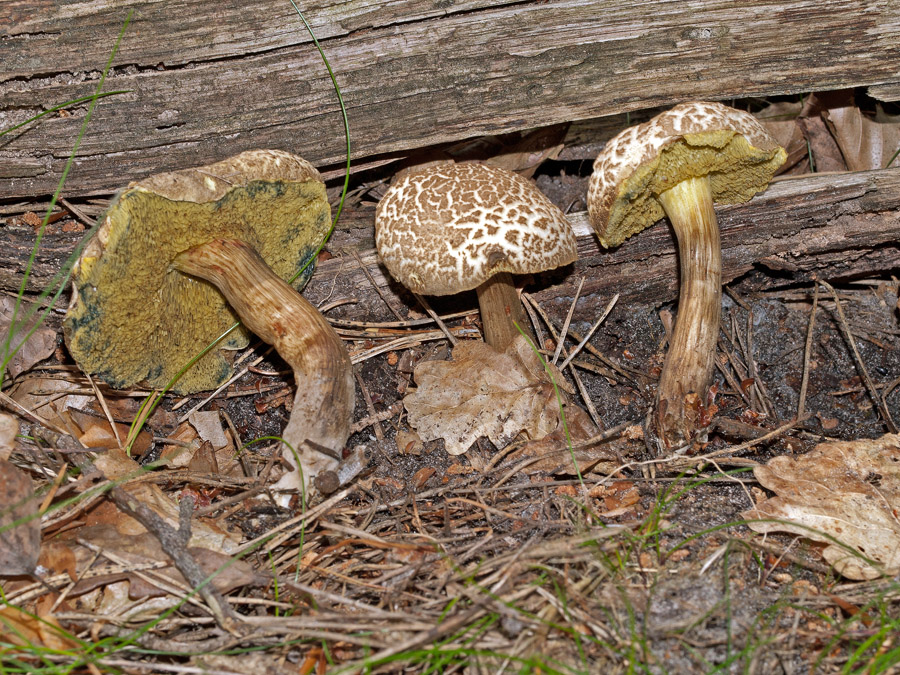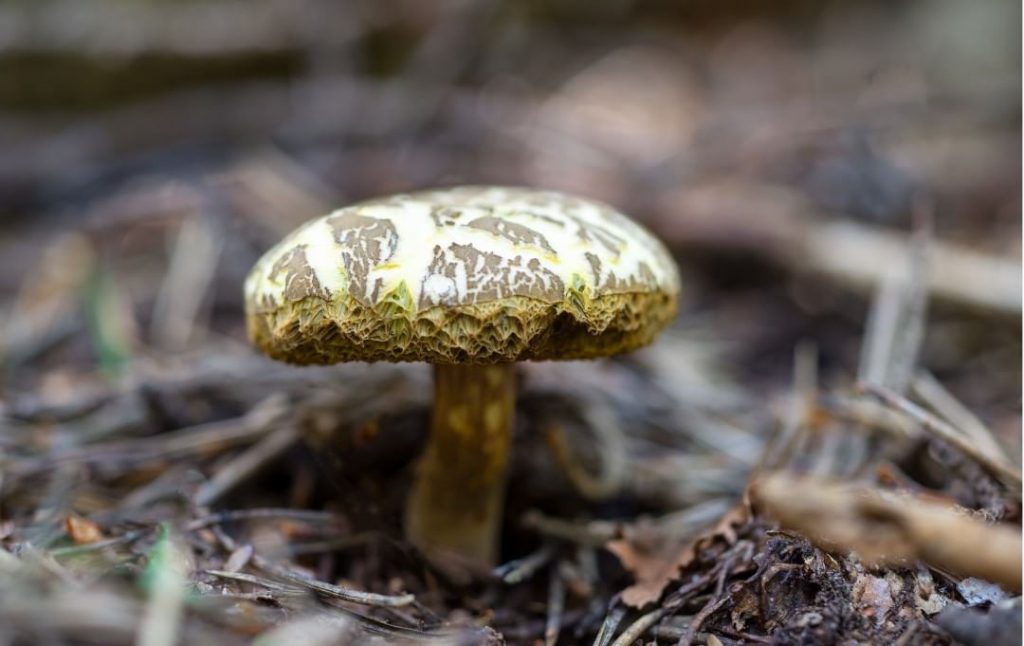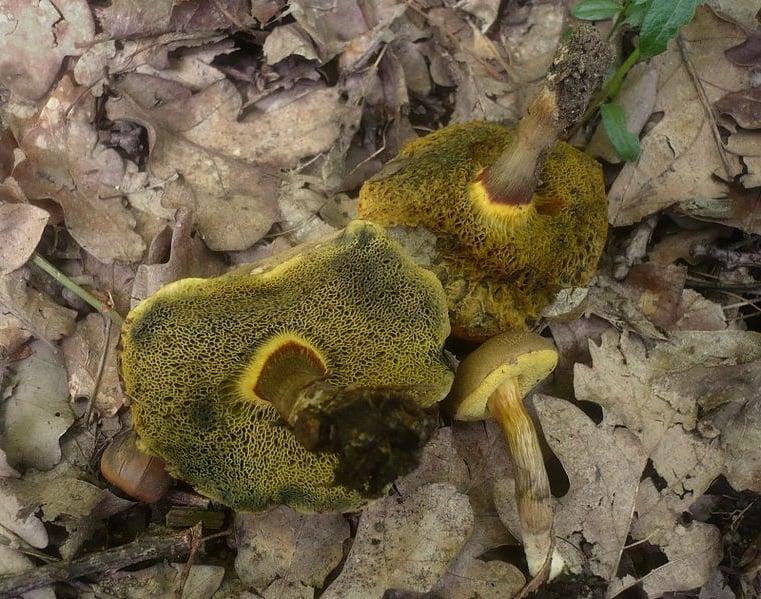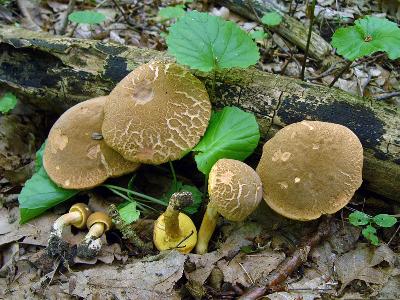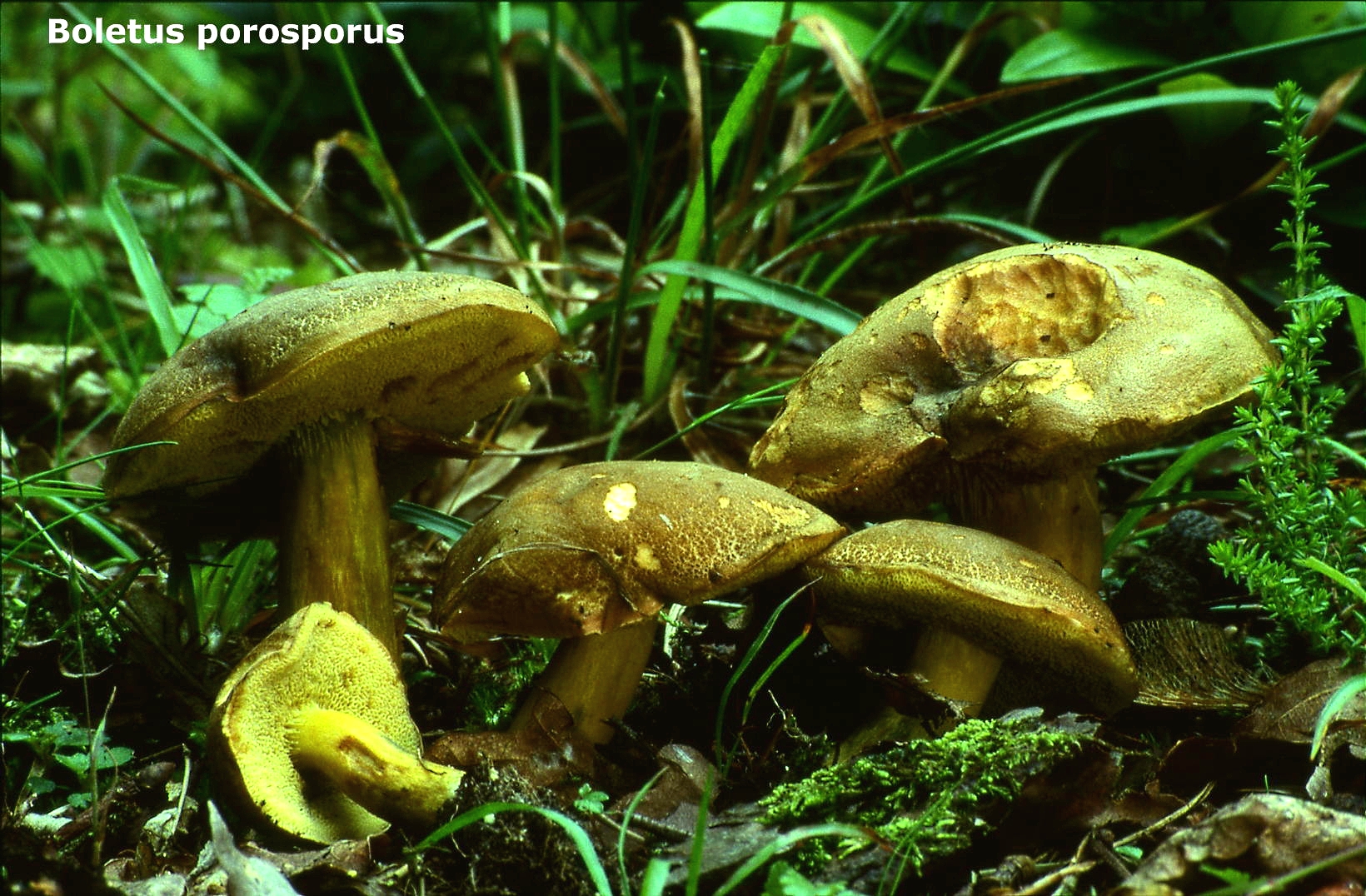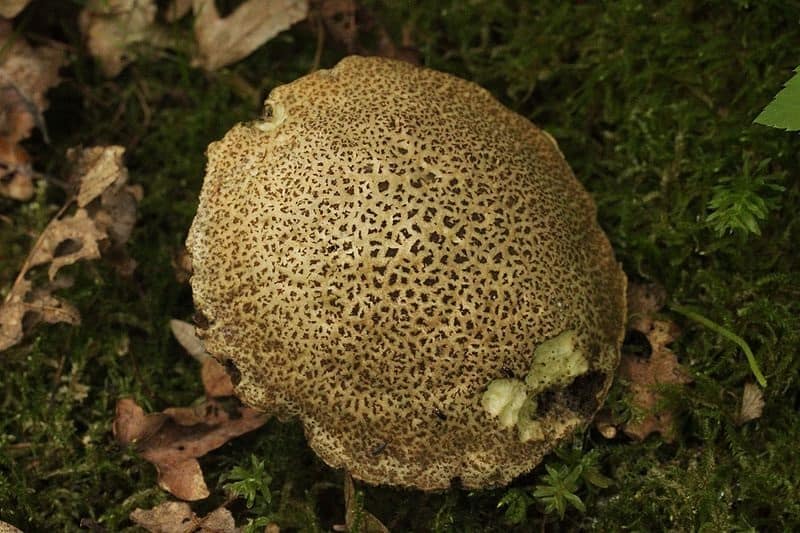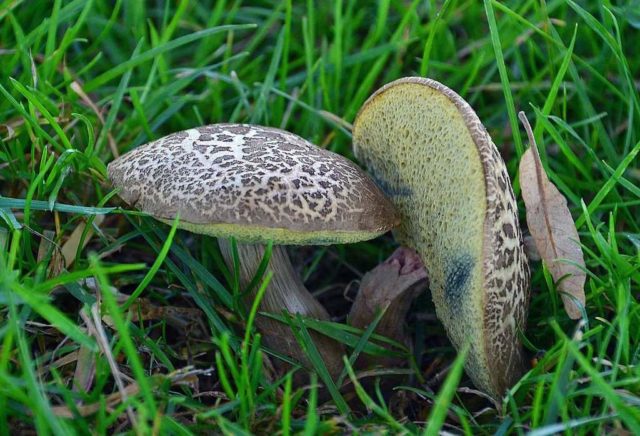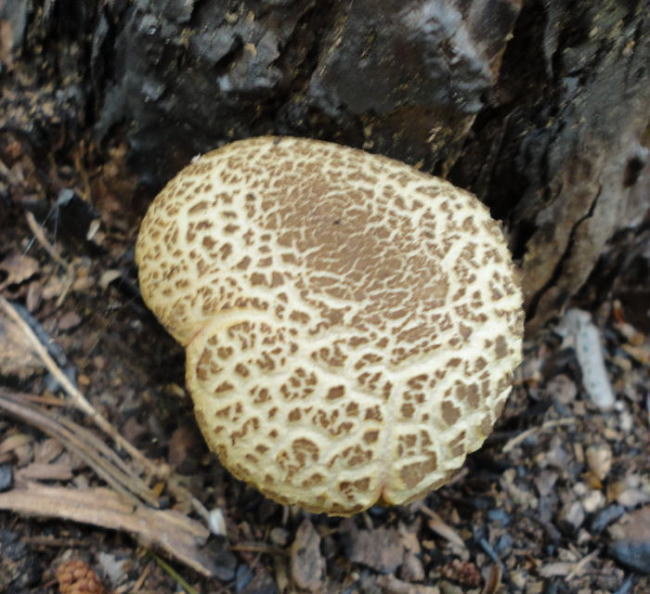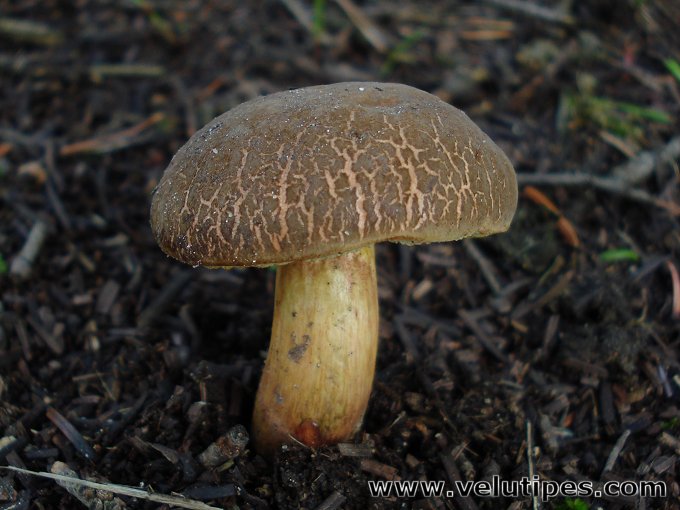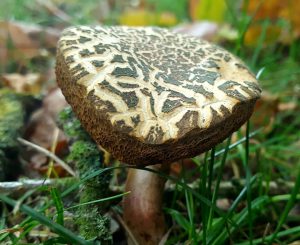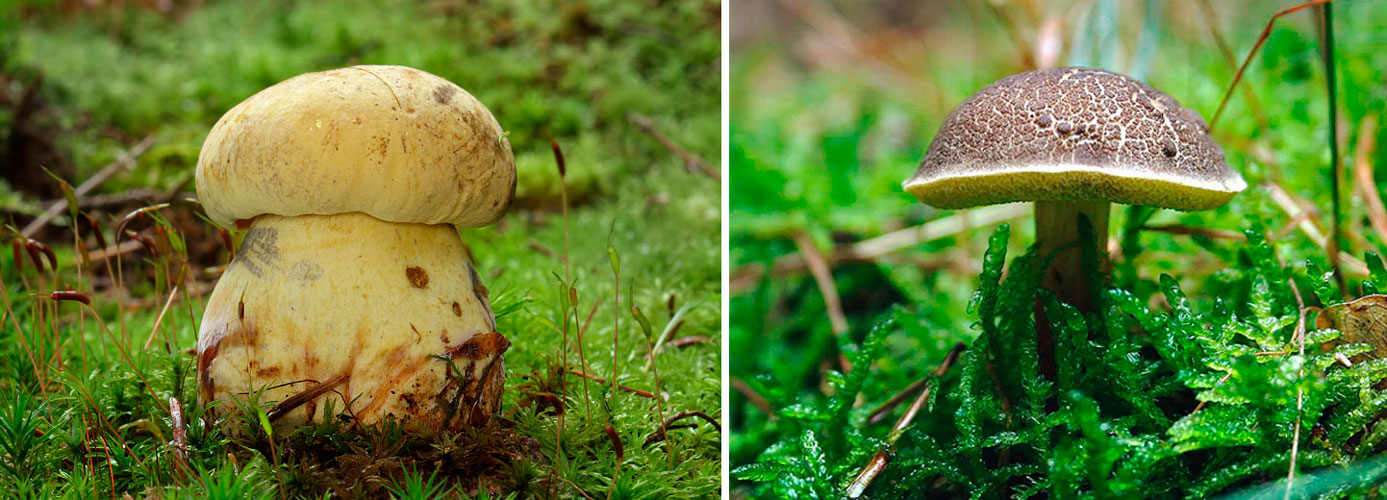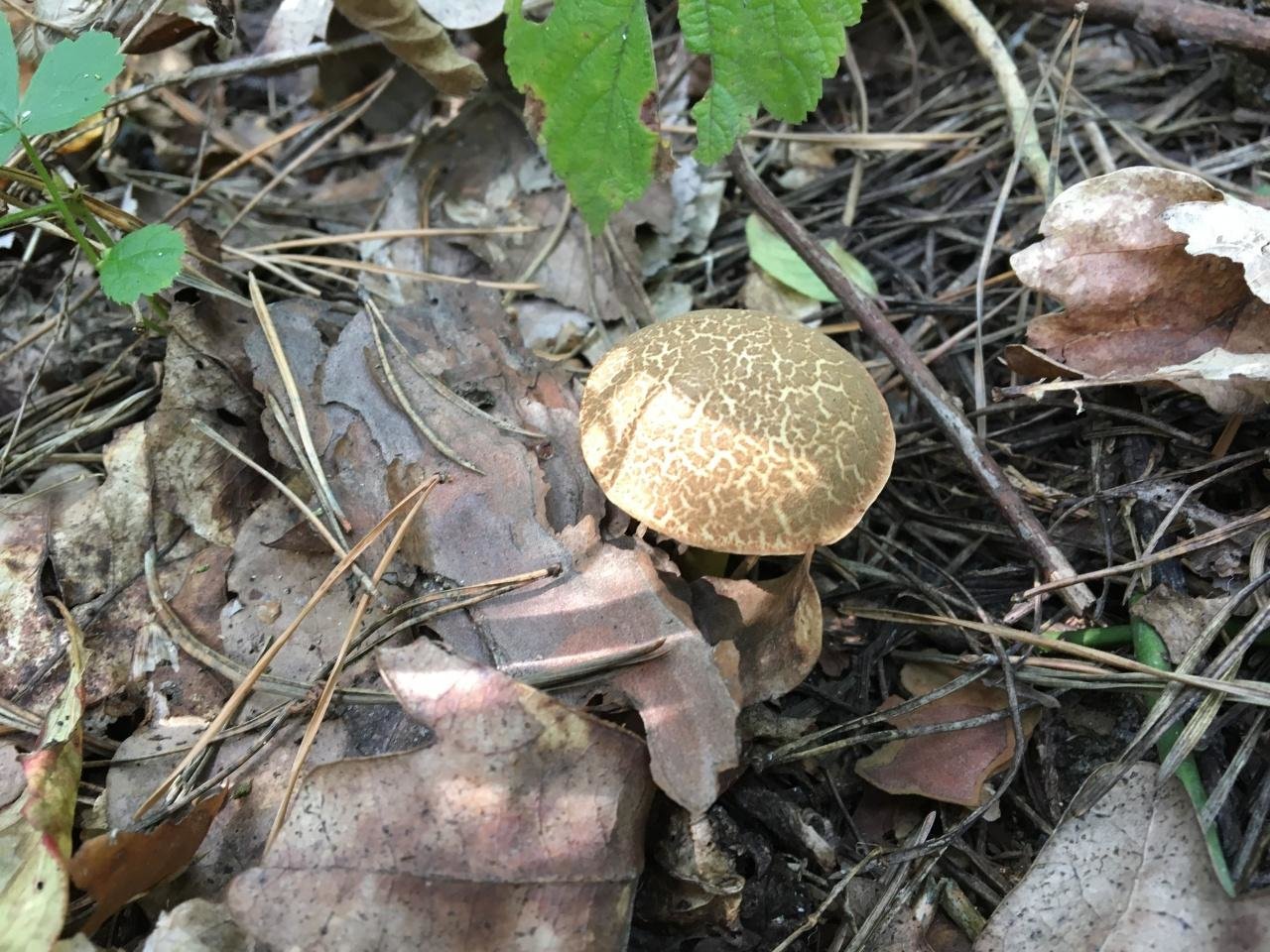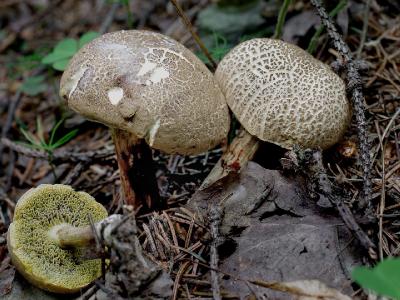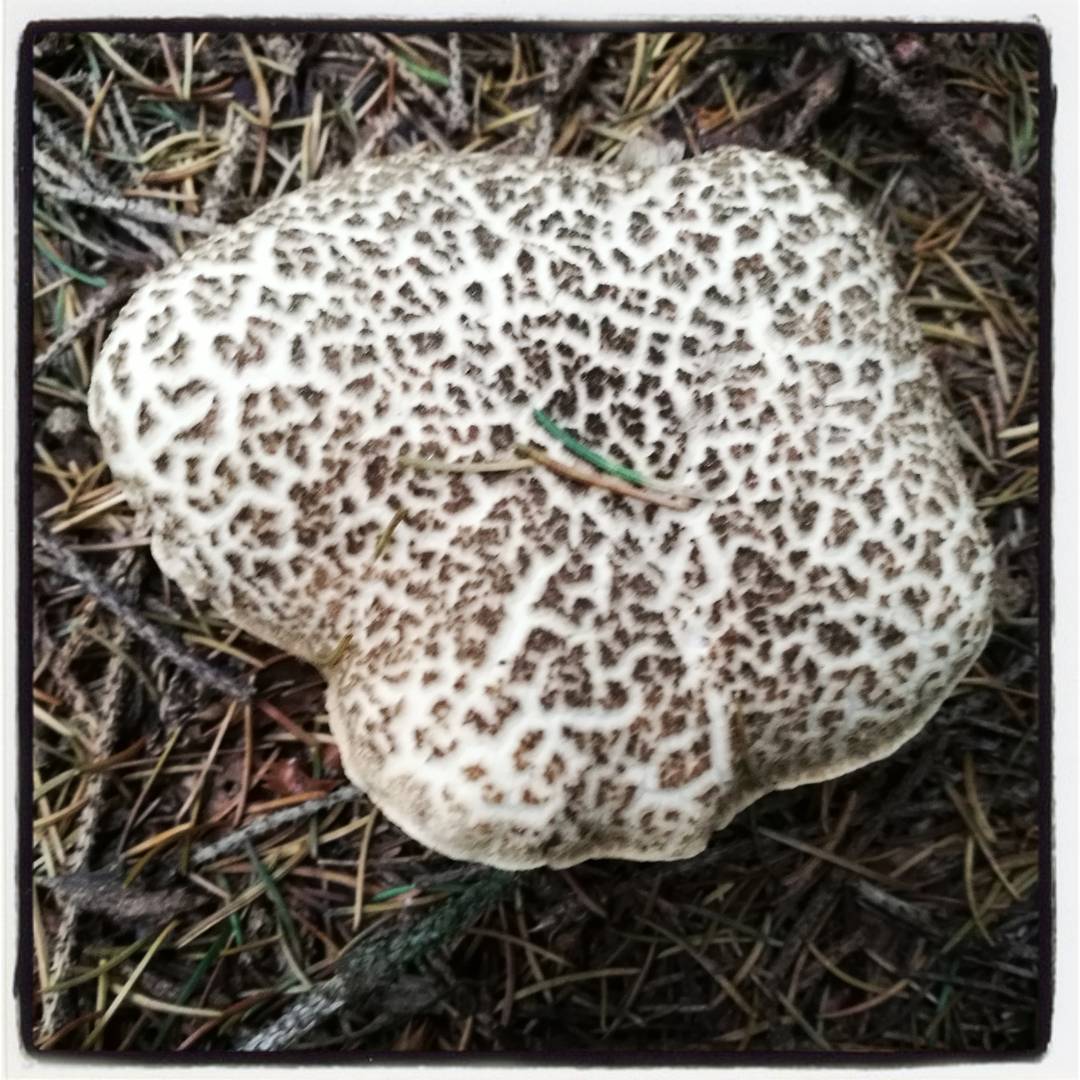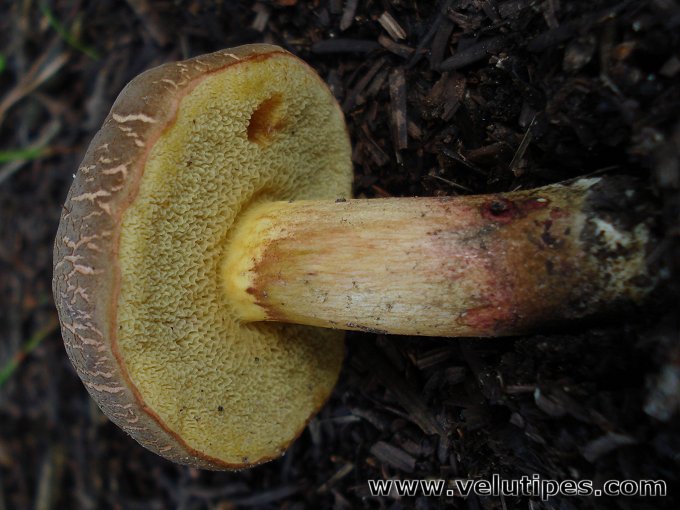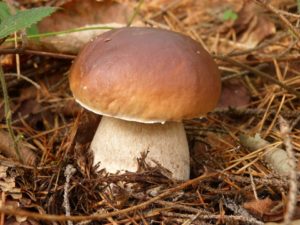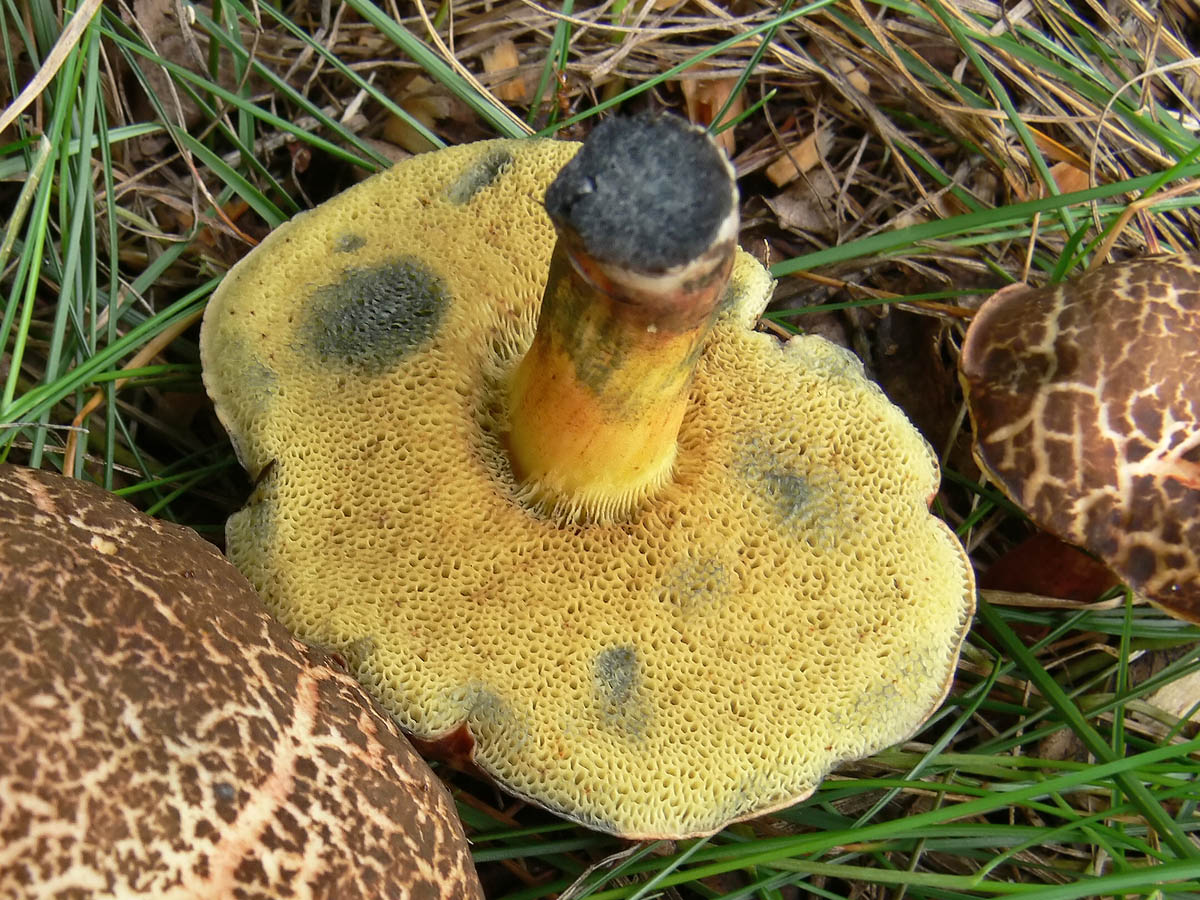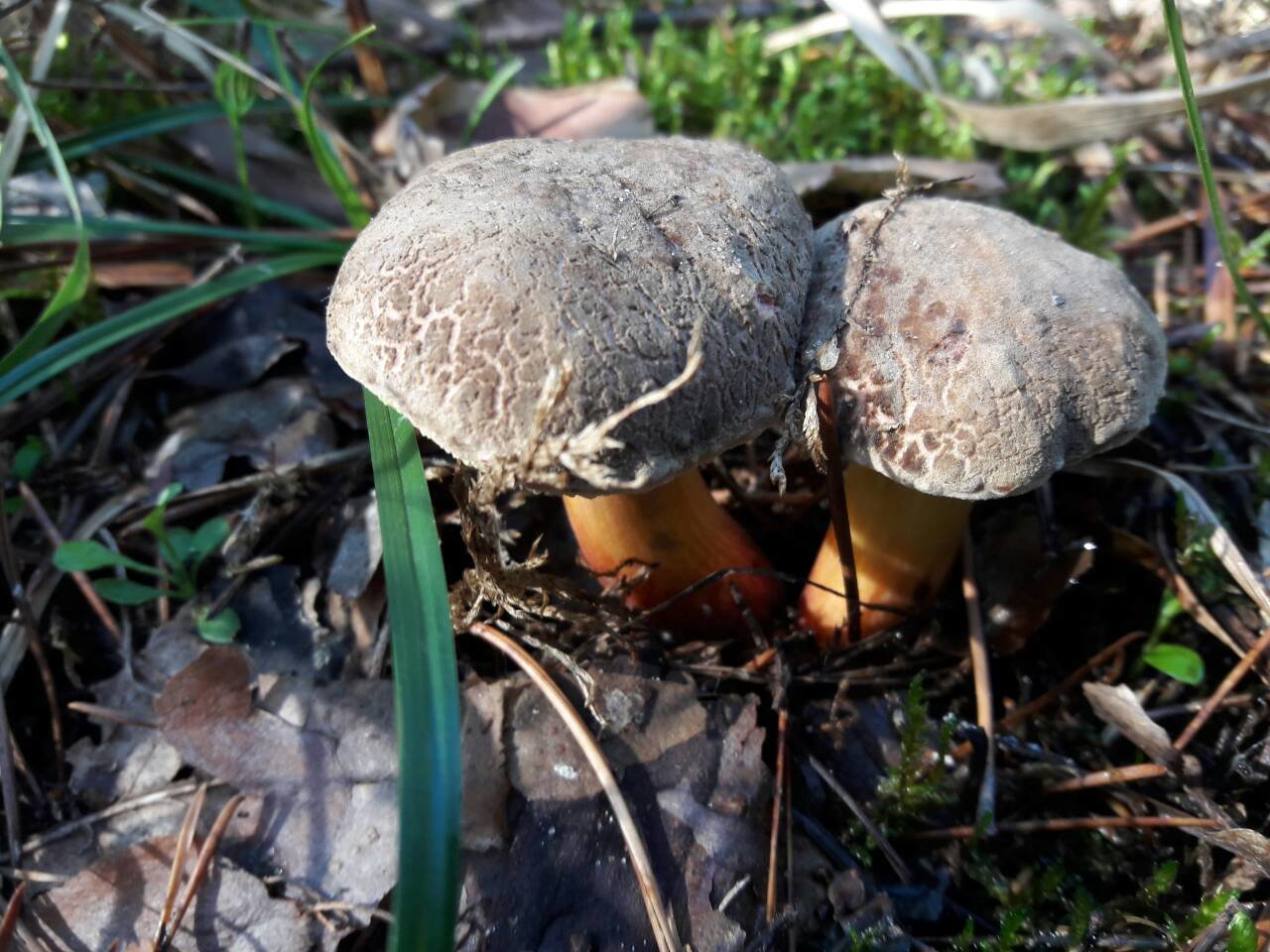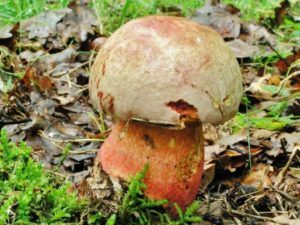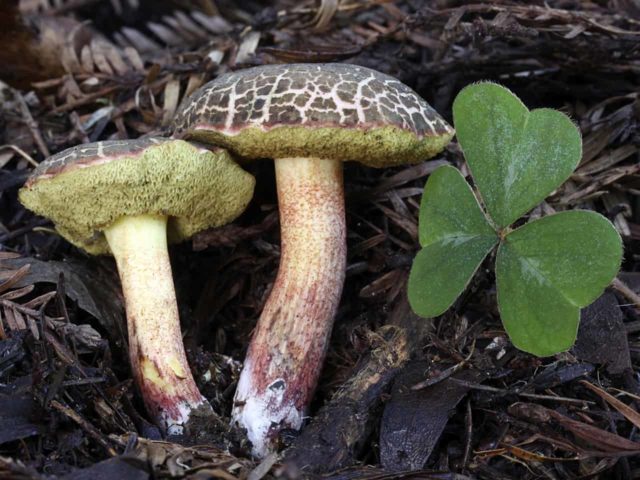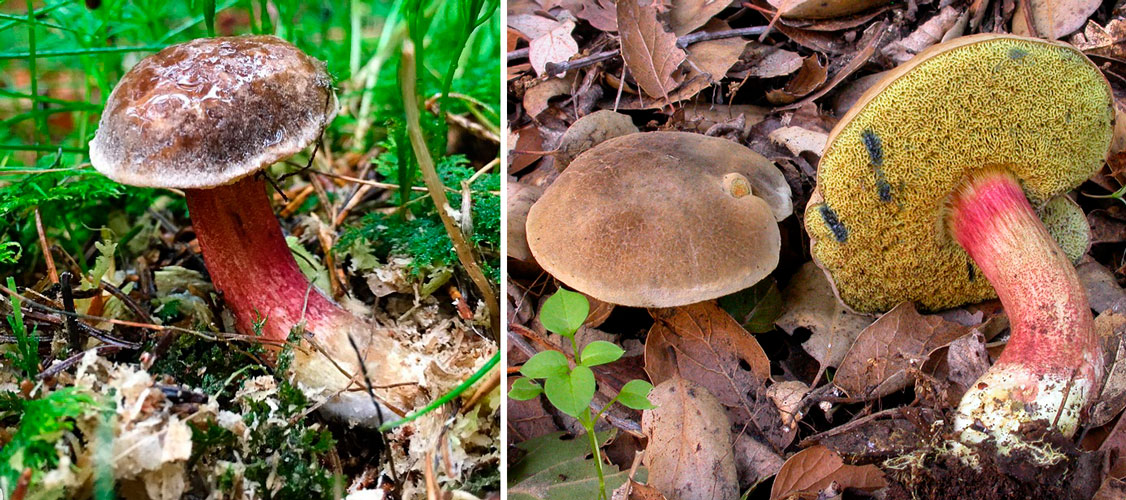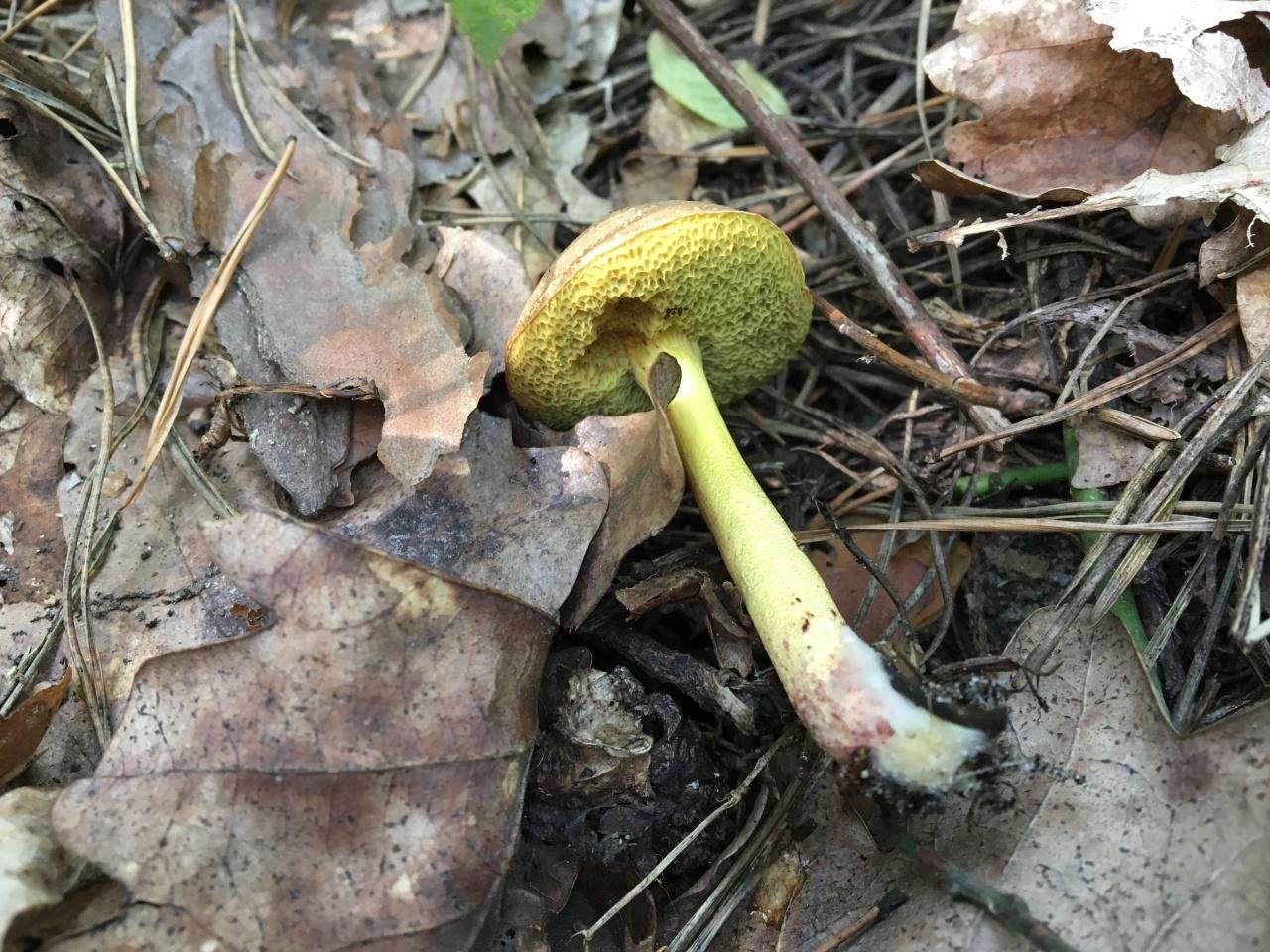Types of mushroom flywheel
Pan mushroom or chestnut flywheel (Boletus badius)
Also known as brown or polish mushroom.
The hat is 4-12 cm in diameter, the shape is semicircular, convex, later becomes cushion and even flat. The skin does not separate, the surface is smooth, dry, becomes sticky in wet weather, matte in young mushrooms, shiny in mature ones. Colored chestnut brown or brown. The pulp is fleshy, dense, whitish or yellowish in color, turns blue on the cut. The aroma is pleasant, mushroom. The leg is 4-12 cm high, 1-4 cm thick, cylindrical, narrowing or widening downward, fibrous structure, light brown, brown or yellow with red-brown fibers.
The mushroom grows next to pines, spruces, beeches, oaks, chestnuts, in conifers, sometimes in deciduous forests, singly or in small groups. The species is distributed in the northern temperate zone of the European part of Russia, in the North Caucasus, in Siberia, in the Far East. The season runs from June to November.
Good quality edible mushroom. Used for freezing, drying and pickling.
Fractured flywheel (Xerocomellus chrysenteron)
The diameter of the cap is 3-7 cm, the shape is convex or cushion-shaped, less often with a depression in the center, the surface is dry, matte, velvety or bare, burgundy-red, brown, olive-brown, brown, brown-red, ocher-gray. The hat cracks, forming a characteristic mesh. The pulp is white or with a yellow tinge, reddish at the base of the leg and under the cap, turns blue at the cut. Leg 4-10 cm in height and 1-2 cm in thickness, clavate, solid, smooth, fissured surface, light yellow with a red base.
The species is widespread in Europe, the North Caucasus, and the Far East. Grows in deciduous and mixed forests. Fruiting from July to September.
An edible mushroom that is eaten fresh and salted, and is also dried or frozen for use in fried and first courses.
Red flywheel (Xerocomellus rubellus)
The cap is 2-5 cm in diameter, cushion-convex in shape, flattens with age. Colored bright red. The skin does not separate, the surface is velvety-felt, cracks in mature mushrooms. The leg is cylindrical, tapering towards the base, 3-10 cm in height, about 1 cm in diameter, solid, fibrous, fine-scaled. The color of the stem is yellow with a raspberry-pinkish, reddish or reddish-brown base. The pulp is dense, yellow, turns blue on the cut.
The mushroom grows in deciduous forests, often in oak forests of Europe, North Africa, Asia. The harvest season lasts from August to September. Does not bear fruit abundantly.
An edible mushroom with a pleasant aroma, the taste is not expressed. Used fresh. Darkens on drying.
Green flywheel (Xerocomus subtomentosus)
The diameter of the cap is 3-10 cm, the shape is pillow-convex, the surface is velvety, grayish or olive-brown in color. The pulp is white, turns blue on the cut. The leg is cylindrical, tapers towards the base, 4-10 cm in height, 1-2 cm in thickness, the surface is smooth, the structure is fibrous.
Grows in coniferous and deciduous forests, in clearings, along roads, singly or in groups. It is a cosmopolitan mushroom, as it is distributed on all continents. Fruiting occurs in May-October.
An edible mushroom, used fresh. Darkens on drying.
Beneficial features
The mushroom mushroom contains nicotinic acid, fiber, micro- and macronutrients, vitamins A, C, D, PP, group B, many amino acids are found in fruits. The product contains a large amount of protein, but its assimilation in the body differs from the meat one not for the better.
The mushroom contains many nutrients that help to strengthen the immune system.The components help fight cancer and other diseases. The product is recommended for infectious and inflammatory pathologies, as well as for the recovery of the body after undergoing surgical treatment.
Other beneficial properties of the mushroom:
- improves blood composition;
- useful for losing weight;
- improves overall well-being;
- has a rejuvenating effect;
- enzymes contained in the product contribute to better digestion of food.
Polish mushroom when it grows. Polish mushroom: features of appearance and distribution area
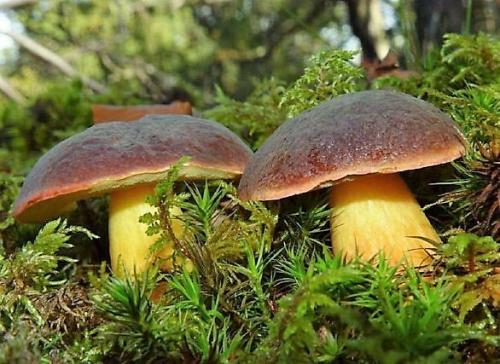
This species, also known as chestnut mushroom or pan mushroom, is a representative of tubular mushrooms and belongs to the genus of mushrooms. During the Middle Ages, Poland was the main country supplying Polish mushrooms to European markets. This is what gave this type of mushroom such an unusual name. Description of the Polish mushroom It is worth starting with the cap. It has a domed shape and is quite large in diameter. In adults, the cap can reach 12-15 cm.The surface of the cap of adult mushrooms is dry and smooth, and in young ones it is velvety. The color of the cap also varies depending on age: from light chestnut to brown. The tubular layer has a white or yellowish-green color. The leg is usually elongated - cylindrical in shape, grows in height up to 14 cm. The diameter of the leg ranges from 1 to 5 cm. And the color can be either yellowish or brown or white-cream. Along the entire length of the leg, there is a pattern in the form of stripes and a relief corresponding to the color of the cap. The pulp of the mushroom in youth has a hard structure, but becomes softer with age. However, the overall Mister-in-the-Hat structure is still meaty. The color is light yellow or white, but in the places of the incision, the color changes to blue. Where do Polish mushrooms grow and how they are harvested?
Collecting Polish mushrooms is not easy. The fact is that the area of their growth is very specific and selective. This species is most widespread in countries such as the Czech Republic, Hungary, Germany, Poland, as well as the Far East region. The Polish mushroom does not tolerate an arid climate, and therefore lives in coniferous or mixed forests, preferring acidic soils.
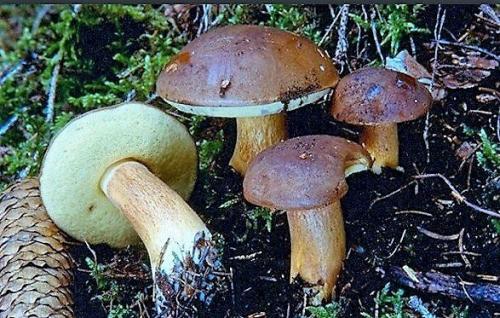
Most often, you can find a Polish mushroom at the base of old trees (oak, pine, etc.) or in a moss bed. The search for this handsome man is facilitated by the fact that he usually settles in groups. The main collection period for this type of mushrooms is in late summer and early autumn. Possessing a fairly high resistance to cold weather, it easily tolerates the first autumn frosts.
Doubles in the mushroom world
In the world of mushrooms, the Polish mushroom is quite easy to confuse with the numerous representatives of the moss and white. Flywheels: variegated, brown and green are the undisputed leaders in this aspect. Many inexperienced mushroom pickers believe that Polish is similar to white. There is some truth in this: young specimens of the Polish mushroom are really close in color, shape and size to white ones.
But there is a simple way to distinguish them: on the cut, the Polish mushroom turns blue, which does not happen in the case of the boletus. The “Polish master” also has poisonous counterparts. Satanic and bilious are similar to him. They are distinguished from the Polish by the color of the cap, the tubular layer and the pattern on the stem. You can also check them by making an incision and observing the color change. The Polish mushroom has a pleasant smell with hints of fruit. It tastes a little sweet. In the culinary business, it can be used in any form. This handsome man does not lose its taste and nutritional qualities during processing, and therefore is suitable for frying, drying, pickling, as well as freezing for the winter.
Boletus is reticulated. Distribution locations and collection times
An amazing white mushroom in all its variety of forms grows everywhere - in gloomy spruce forests, sunny pine forests and under slender light birches.The appearance changes from the variety and place of growth, but an experienced mushroom picker, who knows where and what kind to look for, will never be left empty-handed and will certainly pick up a full basket of noble boletus.
Spruce cep grows in groups in dense spruce forests, most common in temperate climates, appearing after mushroom rains or fogs. You can find it not only in natural forests, but also in parks, artificial plantations under fir trees, less often under other coniferous and deciduous trees. In dry regions, it prefers shady moist thickets, in too humid and cold forests it often settles on open, sun-warmed edges. The harvest time falls at the beginning of summer and lasts until October, the massive harvest is harvested in late August and early September.
In the woods under the pines growing on sandy loam soils, as well as moss and lichen soils, singly or in groups, a pine porcini mushroom grows. It is also capable of forming mycorrhiza with spruce, oak, chestnut and hornbeam. The harvesting season is from early July to late October; they find it even after the first frost. Fruit bodies are harvested until the tubular layer is creamy and has not turned green, and the flesh is still firm.
The birch species grows on any soil, except for acidic peat bogs, in birch forests and birch-aspen forests. It grows singly or in small colonies, likes to settle on forest edges, clearings, in young stands, along forest roads. Harvesting time is from July to mid-October, including the period after early frost.
In deciduous forests, in the shade of sprawling oak trees, an experienced mushroom picker will find grayish oak-like hats. It grows in large families, preferring temperate latitudes and neutral soils. Harvested by cutting off the cap along with the upper part of the leg, from early summer to mid-October.
Reticulated porcini mushroom grows under the canopy of deciduous trees - chestnuts, oaks, hornbeams, beeches. Under the same tree species, there is also a dark bronze species, which especially often settles under dense hornbeams, for which it received its second name - hornbeam. Both species settle on forest edges and lawns, do not like acidic soils, preferring neutral or alkaline ones. The reticulated mushroom is considered one of the earliest, appearing already at the end of May. Hornbeam is harvested later - starting in July, fruiting of both species continues in waves, more massively after mushroom rains, and lasts until October.
On moist loams of deciduous forests in the floodplains of rivers, a rare semi-white ache grows, most often small groups are found under oaks, hornbeams and beeches
The time of collection is June-October, but due to its rarity, it is harvested carefully and in moderation.
Characteristic features and types of false flywheels
Due to the long fertile period (from June to November) and the variety of varieties, the mushroom often becomes an object of interest for mushroom pickers. It has an affinity with boletus, is valued for its expressive taste, and is easy to digest. Grows in mixed coniferous forests, literally forming a symbiosis with trees.
The most striking taste qualities are possessed by red, Polish and variegated mushrooms. Because of this, it is worth knowing that there are representatives of this species, which are considered conditionally edible. These varieties include chestnut, pepper, bilious and parasitic flywheels. Distinctive features of the "wrong" mushroom may be the place of growth, its size, and most importantly - taste.
In order not to be deceived and not to bring home a false flywheel, the mushroom must be carefully studied from the photo and description and understand the visual differences, such as color, size and shape.
Pepper
The harvest time for this variety is from mid-summer to mid-autumn. Pepper mushroom is characterized by the fact that only 2-3 pieces grow on one mycelium. The taste is directly related to the name - burning, spicy.
The diameter of the cap varies from 2 to 8 cm. In the early stages, the shape is convex-rounded, evens out as it grows. Has a soft top layer, can glare in the sun.The hat is light brown, it can have different shades of red. The structure of the pulp is loose, fragile. The color is yellow, with a reddish tint, the red color is enhanced on the cut.
The stem of the pepper mushroom is rather thin, reaching 2 cm in thickness and up to 8 cm in height. Cylindrical, has a smooth surface, the same color as the cap itself, or a shade lighter. The tubular layer, which has pores of various sizes, adheres rather tightly to the body of the leg. The color of the porous layer is brown, sometimes with a red tint. If you squeeze it, then a pronounced brown tint will appear.
Chestnut
The yield period is from July to November. It grows in not very large groups, sometimes one by one. This species is adjacent to such trees as beech, oak, chestnut. This representative is often confused with the Polish one. During heat treatment, it acquires strong bitterness, but absolutely loses it during drying. The chestnut mushroom has a weak smell.
It has a hat with a diameter of 5-8 cm. Its shape is slightly convex, less often it is flat. The color is often chestnut, but it can also be brown, brown, with a reddish tint. The hat is dry to the touch; in dry times, cracks may appear on it due to lack of moisture. The flesh is white, quite firm in the early stages of ripening, becomes firm over time. It does not darken on the cut; when pressed, brown spots appear.
The leg is in the form of a cylinder, the same color as the hat, or a shade darker. Dimensions - length up to 6 cm, width no more than 3 cm. The legs of young mushrooms have a filling similar to cotton wool, while adults are hollow inside. The initially tubular white or light cream colored layer turns yellow as it ages.
Parasitic flywheel
It grows in the summer-autumn period. Based on the name, it can be understood that this species settles on the bodies of other mushrooms. Grows in dry places, on sandy soils. Visually similar to a green flywheel. It has an unpleasant taste, but it is practically odorless.
The hat is convex, 2-7 cm in diameter, the edges are wrapped inward. The colors range from lemon yellow to brown rusty. The surface is velvety to the touch and slightly oily. The pulp is light yellow in color, dense, does not change color at the break.
The parasitic fungus has a very thin stem - maximum 1.5 cm. The height usually does not exceed 6 cm. The shape is cylindrical, the structure is fibrous, and solid. Coloring - olive, yellow. The pores of the tubular layer are colored to match the cap, wide, with ribbed edges.
Bilious
Fruiting from June to October in deciduous and coniferous forests. It grows both singly and in groups. Has a characteristic bitter taste that causes a burning sensation.
The hat can be 4-15 cm in diameter, has shades from yellow-brown to light brown, more often of a light color. The shape is hemispherical in young representatives and more rounded, outstretched in mature ones. The pulp at the early stages of ripening is white, with age it acquires a pinkish tint. The structure is fibrous, or odorless, or with characteristic mushroom notes.
The shape of the leg is often cylindrical, swollen from below. Height 3-13 cm, width 2-3 cm. When ripe, the leg is covered with a dense mesh of small fibers that have a brown or gray color. A distinctive feature of this species is that when it breaks, it immediately darkens, acquires a brown color. The gall fungus is rarely affected by insects and worms.
External signs of porcine boletus
The diameter of the cap reaches 8 centimeters. The shape of the cap is convex, most often it looks like a hemisphere or pillow. The skin on the cap often cracks, resulting in a net of whitish cracks on the surface. This reticular pattern is a characteristic feature of the porous boletus and allows it to be distinguished from other members of the genus. The color of the cap is gray-brown or dark brown.
The pulp is dense, thick, whitish in color. The pulp has a pleasant aroma - slightly fruity. Tubular layer of bright lemon-yellow color. When pressed, it turns blue. Spores are smooth, fusiform.Spore powder olive brown. The leg of the boletus is porous gray-brown in color, and the base is darker.
Areas of growth of porous boletus
Porcotic boletus grows mainly in coniferous and mixed forests. Porosporous boletus bear fruit in summer and autumn - from June to September.

How to cook boletus
First of all, boletus is cleaned of dirt and debris. And then the mushrooms are soaked in cold water for 5 minutes, and the water is drained. The boletus is cut, and if they are small, they are immersed whole in boiling water. When the boletus boils, remove the foam and reduce the heat.
Boil the mushrooms for 10 minutes, then drain the water and pour in clean water. Now they are boiled again for 20 minutes. When the boletus sinks to the bottom of the pan, they are cooked.
Related species of porous boletus
Boletus fine - a poisonous representative of the family. It causes stomach upset accompanied by diarrhea, abdominal pain and vomiting. There were no deaths from poisoning.
The cap diameter of this large mushroom is 7.5-25 centimeters. Its shape is hemispherical, the surface is woolly. The cap color ranges from reddish to olive brown. The leg length is 7-15 centimeters, and the width reaches 10 centimeters. The shape of the leg is swollen. The color of the leg is red-brown, the lower part of the leg is covered with a dark red mesh.

Boletus boletus are common in North America, they grow in mixed forests. These fungi form mycorrhiza with conifers. Beautiful boletuses bear fruit from late summer to late autumn.
Boletus yellow is an edible mushroom. The diameter of its cap ranges from 4 to 16 centimeters, but sometimes reaches 20 centimeters. The shape of the cap is hemispherical at a young age, and then becomes flat. The skin can be smooth or wrinkled. The color is yellow-brown. The leg is thick, tuberous, its height is 4-12 centimeters, and its width is 2.5-6 centimeters. The color is the same as the leg.
Boletus yellow grow mainly in oak and beech forests. They are common in Western Europe and Russia. Yellow boletus bear fruit from July to October. In terms of nutritional value, they belong to the 2nd category of edible mushrooms.

What a Polish boletus looks like. Polish mushroom
Home> Mushrooms> Polish mushroom
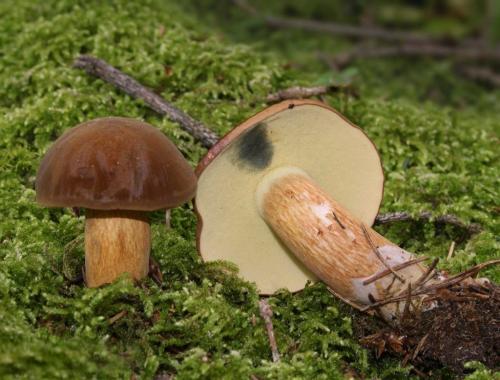
Polish mushroom or chestnut mushroom is a special delicacy that is not available to everyone. It has many useful elements and is quite rare in nature. He received the greatest distribution in Europe and the Far East. The Latin name for the mushroom is Xerocomus Badius.
Other names - Brown mushroom, Pan mushroom, Chestnut moss
Polish mushroom: description
In appearance, the Polish mushroom is very similar to the white one. It is characterized by a brown hat, which can take on both light and dark shades. The brown mushroom is always slippery during the rainy season and dry in dry weather. Smaller specimens often have a rounder head. As it grows, it becomes flat. It is very difficult to separate the skin of the Polish mushroom. In the stem of the mushroom, yellow tubes very often accumulate, and the color of the legs can be from yellow-brown to red.

Chestnut flywheel can reach large sizes
It is worth paying attention to the fact that the Polish mushroom does not accumulate radiation and poison, therefore such a mushroom does not pose a danger to humans. It grows in ecological areas, especially in deciduous and coniferous forests. It is very easy to distinguish a real edible mushroom from a double.
In nature, mushrooms similar to Polish are rarely found. However, when collecting chestnut mushrooms, you should pay attention to the poisonous and dangerous Satanic mushroom. It has some similarities, but in order to avoid such a mistake, it is worth knowing everything about the peculiarities of Polish mushrooms. When collecting such brown mushrooms, the mushroom picker will be able to notice how their caps begin to change their shade - instead of brown, they acquire a pronounced blue. The hat can also change color if the mushroom is pinned down.
Features of preparation and primary processing
Before preparing Polish mushrooms, it is important to thoroughly prepare them, which consists in primary processing
It is important to take into account the fact that a lot depends on the recipe for preparing such mushrooms. After you return home from the forest, you need to thoroughly wash and peel the pan's mushrooms. All wormy places must be removed immediately, you also need to get rid of the leaves that could get to the mushrooms during the process of collecting them
All wormy places must be removed immediately, and you also need to get rid of the leaves that could get to the mushrooms during the process of collecting them.
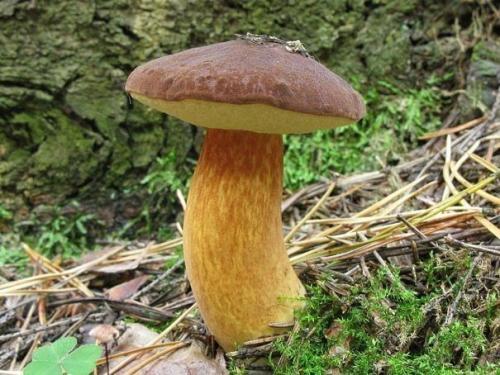
After that, you need to rinse the Polish porcini mushroom under running water and soak them in cold water, adding a little salt. They should be in such a solution for 6 hours. During this period of time, they will become solid, and the worms that were in them will die. The mushroom debris will settle to the bottom, so just rinse them and you can start cooking. Boil the mushrooms in a large enamel pot. They need to be filled with water and put on fire until the water boils. After that, you need to drain it and pour new water.
Cooking recipes
- One of the most common cooking methods is pickling mushrooms. Mushrooms are especially tasty in this type. This will require vinegar, salt, pepper and some vegetable oil. All this is mixed and mushrooms are added. When marinating, you do not need to add water - chestnut mushrooms, upon contact with vinegar and seasonings in a saucepan, will release a liquid, which will act as a marinade.
- Also, the flywheel will perfectly decorate the soup, giving it a more expressive taste. Before adding the mushrooms, it is recommended to fry them for 5-7 minutes over low heat.
- Fried mushrooms with onions are a complete and tasty substitute for meat. Before frying, chop the mushrooms and onions, and then pour into the pan, adding vegetable oil. After the mushrooms release the juice, cover the pan with a lid. You need to fry the mushrooms until tender. Onions are often fried separately.
A salad with fried or pickled Polish mushrooms will become a real decoration of any festive table.
Polish mushroom-0,5l. Provencal mayonnaise 72% or 67%. Natural processed cheese curd 100 g. Potatoes (5-6 pieces). Pickled cucumber 2-3 pcs. (it is better for someone to have a citric acid marinade than vinegar). Greens to taste.
Harvesting moss
There are a large number of recipes for making a flywheel: the product is boiled, dried, fried, pickled, frozen, canned. Add to meat and vegetable dishes, salads, soups. Canned mushroom goes well with potatoes, rice, buckwheat, cabbage. Before cooking, the product is thoroughly washed and cleaned. Various spices are added to taste, which make it softer and more aromatic. Delicious broth, caviar, mushroom paste are prepared from the mushrooms.

mushrooms are used in cooking to prepare delicious and healthy dishes
Cooking recipes
Polish mushroom (Xerocomus Badius) is used to make mushroom paste. To do this, use the following ingredients:
- 1 onion;
- 1 clove of garlic;
- 700 g brown mushrooms;
- 5 juniper berries;
- 2 tsp salt;
- 4 tsp balsamic vinegar;
- 4 tsp honey;
- 1 handful of pitted prunes
- 100 ml of rapeseed oil;
- ½ tsp pepper;
- 1 tsp rosemary.
The mushrooms are carefully peeled and chopped. Heat the oil in a saucepan, add garlic, cook it until it becomes golden and fragrant, after which the product is pulled out of the container. Put chopped onion in a saucepan, cook it until softened. Then add mushrooms, prunes and salt. Cook for 20 minutes, then add balsamic and wine vinegar, honey.
Flywheels go well with potatoes. For cooking, use the following ingredients:
- potato;
- butter and vegetable oil;
- sour cream;
- salt;
- pepper;
- onion.
How to cook:
- Peel and chop the potatoes.
- A small amount of vegetable and butter is poured into the pan. Fry potatoes until tender, add salt and pepper.
- At the same time, mushrooms are prepared: they are washed, cleaned, placed in a deep container, water is added, and simmered over low heat until the liquid evaporates.
- Then put butter, salt. Fry for another 8-10 minutes.
- Potatoes and chopped onions are added to the mushrooms. They keep on fire for several minutes, after which they are served with sour cream.
Polish mushroom, how to cook. Selection and preparation of ingredients
Since the Polish mushroom prefers coniferous forests, where sandy soil usually predominates, the mushroom harvest there is often heavily contaminated with sand and needles. To thoroughly wash the product, it is placed in cold water for a couple of hours.
Important! Due to the delayed digestibility of the product, it is recommended to grind it during cooking. Heat treatment in this case will be much faster and more efficient, simplifying the process of further digestion of the gastrointestinal product.
In the process of soaking, the liquid is replaced several times, after which it is drained, and the crop is carefully sorted out. It is necessary to remove the wormy fruits and cut off the tips of the legs.
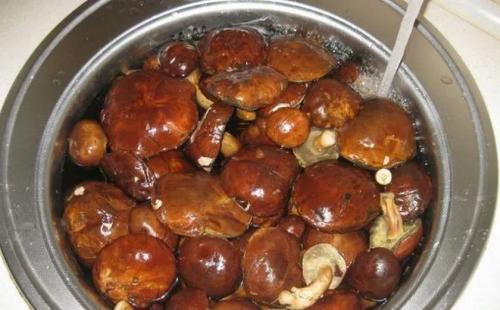
Polish mushroom recipes
This forest product is equally good fried, boiled, pickled and salted. It is used in main dishes,
Marinovka

2 cans, 0.7 l each 35 min.
Steps
10 ingredients
polish mushrooms
2 Kg
table vinegar (6%)
7 tbsp. l.
water
1 l
granulated sugar
1 tsp
salt
2 tbsp. L.
allspice (peas)
4 things.
Carnation
1 PC.
black pepper (peas)
3 pcs.
laurel leaf
1 PC.
juniper (peas)
3 pcs.
- Prepare a marinade, for which add salt, sugar and spices to boiling water.
- After dissolving sugar and salt in water, add vinegar to the marinade.
- Place the cooked product in the solution and boil for 5 minutes.
- Put the jars in a large container with water and sterilize over the fire for 10 minutes.
- Place the fruits in sterilized glass jars, leaving a few centimeters between the edge of the neck and the mushroom layer.
- Pour the marinade over the jars. Its level should be at least one finger above the mushroom layer. Seal the container hermetically with sterilized lids.


